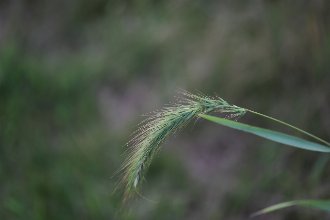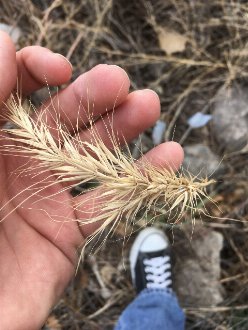Canada Wildrye (Elymus canadensis L.)
↑Summary
A short-lived perennial, cool-season grass native primarily to the great plains, also extending well into the west and northeast.
↑Range - Expand
| Legend | Color |
| Native | |
| Expanded | |
| Native or Not Present | |
| Expanded or Not Present | |
| Native or Expanded or Not Present |
This tentative map is based on our own research. It may have limited data on Canada and/or Mexico, and there is some subjectivity in our assignment of plants as introduced vs. expanded. Read more in this blog post.
Although this plant occurs somewhere in each of these regions, it may only occur in a small part of some or all of them.
This plant is not native to California. It was a difficult judgment call whether to mark it introduced or expanded there; we chose expanded because of proximity to populations in Nevada and Arizona and also that it is native farther north in Oregon.
↑Similar Plants
↑Habitat
Canada Wildrye is most abundant in the great plains, where it is a dominant component of tallgrass prairies and also found in mixed grass prairie, and tends to be more common in bottomlands. In more arid areas to the west, it occurs in the banks of ephemeral streams, in meadows on valley floors, and in other riparian or bottomland habitats. Both in the northeast and west, it is also found in savannas and open forests, and can occur in openings in both hardwood and mixed evergreen-hardwood forests. In forested regions, typically found where coarse sands, rock outcroppings, or disturbance has created more open conditions. Also found throughout its range in anthropogenic habitats, including fallow fields and along roadsides and railroads.
Tolerant of nearly all soil textures, including gravel/rock, sand, loam, and clay. Tolerates heavy metal contamination and exposed, eroding soils. Tolerant of low nutrient levels and especially tolerant of low phosphorus levels. Tolerates some soil salinity, especially in the interior West. Usually prefers mesic soil conditions, but moisture preferences vary throughout its range. Grows well on both flat ground and slopes, and handles steep slopes better than many grasses.
Found primarily as a pioneer species of disturbed habitats, and frequently colonizes habitats disturbed by flood, summer fire (not early spring fire), or anthropogenic disturbances. Where it occurs on disturbed sites, it prefers larger-scale disturbances than other Elymus species.
Humans effect on this species have been mixed. It is threatened by quackgrass (Elymus repens) and Kentucky bluegrass (Poa pratensis), two invasive species that tend to outcompete it; humans have widely spread Kentucky bluegrass through its use in lawns. At the same time, humans also widely plant Canada wildrye, and create frequent disturbances, such as along roadsides, that tend to favor it over other later-successional grasses.
This species sometimes occurs together with other Elymus species in the same habitats. In forested areas, it prefers larger gaps opened by larger-scale disturbances than those favored by other Elymus species. Relative to Virginia wildrye (Elymus virginicus) it ranges into drier habitats but is less shade-tolerant. It prefers more mineral-rich soils than southeastern wildrye (Elymus glabriflorus).
↑Life Cycle
Canada wildrye is a short-lived perennial that relies more on reproduction by seed to persist on most sites, relative to other Elymus species. As a cool-season grass, it emerges earlier than most of the grasses in the tallgrass prairies where it is dominant, and goes mostly dormant during the peak of the growing season.
Seeds germinate in the spring and develop rapidly, with plants reaching full height, flowering, and producing seed production in the same year. Already-established plants reemerge around the same time, often sending up multiple stems. Root and shoot growth is rapid during periods of cooler temperature, and slows down as temperatures warm. As moisture becomes more scarce, the leaves often wither, starting from the base of each stem. The lower leaves are usually withered before the plant flowers.
Seed production on individual plants often peaks in the 2nd or 3rd year, after which plants decline and then die.
Under favorable conditions, plants will reproduce by short rhizomes. Rhizomes are most likely to form in loose, sandy soil and less likely in rich loams.
In fall, new growth low to the ground is produced, typically growing to about 1 foot in height; this growth is semi-evergreen, staying green in warmer winters and on more sheltered sites, but dying down in harsher conditions.
↑Uses
Canada wildrye is highly effective for revegetation and soil stabilization on disturbed sites, due to its ability to thrive on such sites and establish rapidly. It is effective for erosion control and it tends to build up organic matter at the soil surface.
The early growth of this species is considered good forage for livestock, but it is considered inferior later in the season, and particularly poor when seeds develop as the sharp awns can irritate the mouths and digestive tracts of animals.
This species can also be used in landscaping, where it is valued for being easy to grow, its attractive seedheads, and its semievergreen foliage during the cool season. It can be grown as an ornamental bunchgrass, but is less suited to this end than other Elymus species due to its short-lived nature and tendency to spread aggressively by seed. It functions better in mass plantings where it can reseed itself freely.
↑Links & External Resources
• Canada Wildrye | Fire Effects Information System (FEIS) (About This Site)
• Elymus canadensis (Canada wildrye) | USDA PLANTS Database (About This Site)
• Elymus canadensis | Go Botany (About This Site)
• Canada Wild Rye | iNaturalist (About This Site)
• Elymus canadensis (Canada Wild Rye) | Missouri Botanical Garden Plant Finder (About This Site)
• Elymus canadensis | Biota of North America Project (BONAP) (About This Site)
• Canada Wild Rye (blue form) | Illinois Wildflowers (About This Site)
• Elymus canadensis | NatureServe Explorer (About This Site)
• Elymus canadensis | Flora of North America (About This Site)
• Canada Wildrye | Maryland Biodiversity Project (About This Site)
• Elymus canadensis L. var. canadensis (Nodding Wild Rye) | Digital Atlas of the Virginia Flora (About This Site)




















